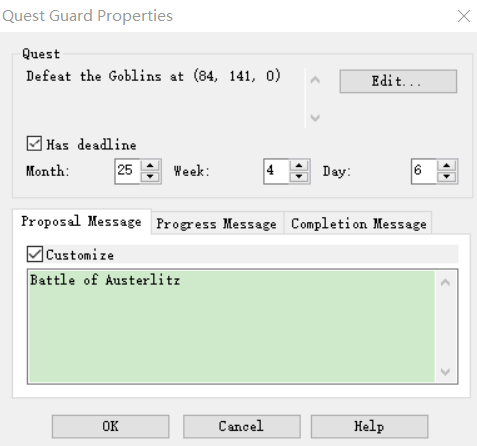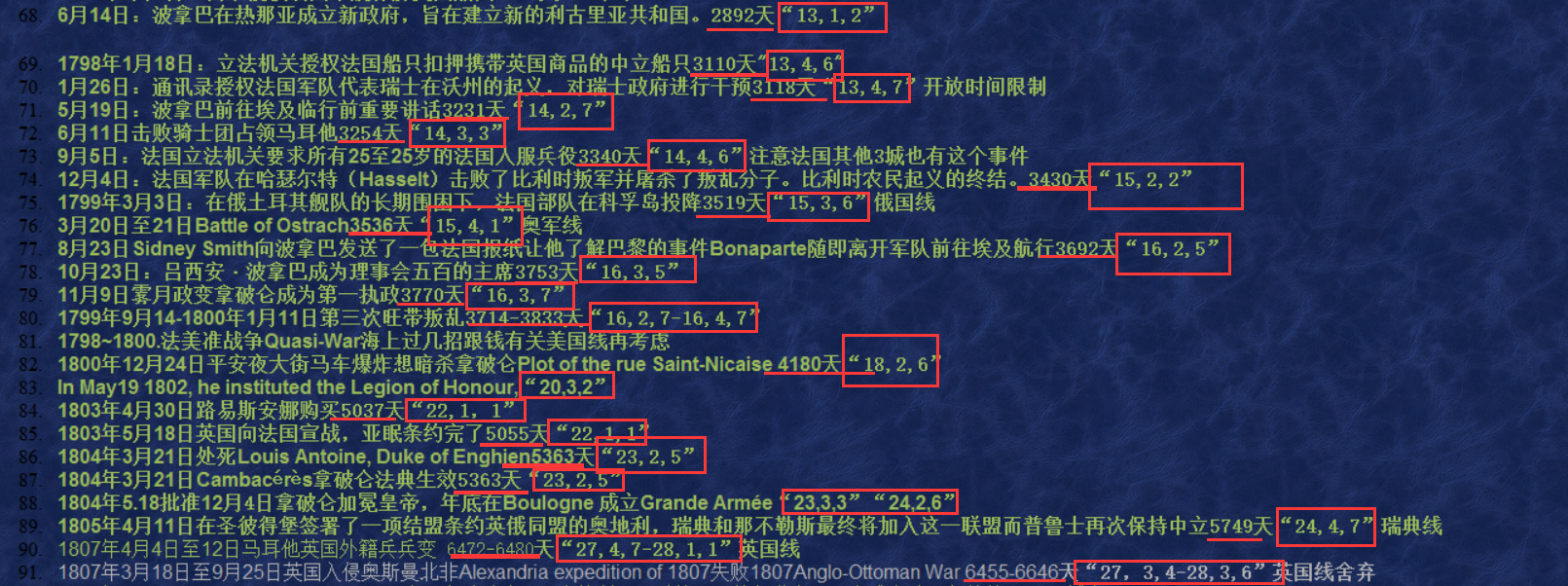
我们知道游戏中有一个重要的参数,那就是日期,它的格式是‘月a,周b,日c’,它时刻告诉玩家当前所处的确切回合。 但大西洋革命战纪地图中除了北美和南美势力的剧情一个早于1789年起始,一个晚于1815年结束,其余6个势力英,法,奥地利,俄国,西班牙,瑞典共同演绎的历史时间区间均介于1789年7月14日(法国大革命)~1815年6月18日(滑铁卢战役)之间,舍去月份零头的1个月差距后刚好共计26年整,也就是有26个365天,如以现实的一天换算游戏的一天需要26年未免太长了,因此必须引入‘现实历史-游戏时间尺度换算’这一概念来进行一定的转换。 如果用游戏中1天代表现实历史中7天(1周), 那么游戏中7天(1周)就代表了现实中的49天(7周),为了进一步压缩,对其进行四舍五入,使其代表现实中的60天(2月)。26*365(1789-1815历史区间总天数)÷60(游戏中1周代表的现实天数)≈158
但这只是我们假定的换算方案,其合理性怎么样,就需要进行验证:
1.于时间上,这个7-60的换算方案显然是合理的,因为158个游戏中的周来同步演绎这段大西洋革命历史,158÷4≈40,也就是40个游戏中的月,这样就比较合适了,因为很多大型地图若不是追求极限通关,完成时间通常也会达到20个月。
2.于空间上,由于游戏中英雄平均每回合的移动力通常是1500点至2000点,也就是说不管在哪个地图里,玩家控制的英雄大概能在一个回合内我们完全可以假定它就是2000点,但是由于不同的地图尺寸不同,144尺寸的地图就是144*144个格子,而本地图则为252*252个格子。那么,同样用2000点去朝一个方向走一个回合,英雄走过的格子的数量虽是一样的,大概是20格(反正应视为是恒定不变的一个定值),但是走过的这些格子数量占总格子的比例不同,在本地图中这个比例是20/252。而本地图总的252*252的区域内,装着的是几乎整个欧洲大陆,所以这一个回合内,英雄不光是在游戏地图里走了一些格子,更是代表着率军在欧洲大陆上行进了一段距离!之前20/252这一比例意味着,走14回合就能从地图上的西欧法国的西部,来到地图东部的俄国境内!而在现实历史中,拿破仑战争前后的那段时期,蒸汽机车尚未发明,部队行军依旧是传统的步兵走路,马车拉货,最快有骑兵骑马。从西欧到俄国,如果用拿破仑大军入侵俄国来参考,这足足需要以较快的急行军速度日夜兼程走4个月,更别说还不能中途停下来打一些仗,因此就按4个月来计算。
3.这样一来,就意味着游戏中的14回合,走了现实中4个月,即120天的路程!14:120,约分后,恰好正是之前于时间上的7-60!出现这样惊人的吻合,难道是巧合?不,这跟20/252这一比值有重要联系,倘若地图不是252,或者英雄每回合能走的格子不是20,最终这个比例就不会是这样刚巧。
由此可见这种‘游戏中7天代表现实历史中60天’的转化关系具有较高的合理性,对本252地图来说,7-60这个系数于空间于时间的双重合理性。所以我们的‘现实历史-游戏时间尺度换算’这一概念正式有了明确的标准,也就是7-60,更简单地来说,当玩家在玩本地图的时候,将自己代入到了那段历史中去了以后,每当新的一个游戏周到来时,心里要能够明白等于说现实历史对应过去了两个月。这一点认知非常重要,能够帮助玩家预测很多地图中将要发生的事情,比如一些副本的期限是否即将临近,比如不妨先猜一下发生于1805年的奥斯特里茨战役,是本地图上的一个重要副本,它的期限在游戏的守卫上大概会显示多少?它距离1789过去了16年,16年是两个月的96倍,那么守卫期限也会是7个游戏回合(1个游戏周)的96倍,也就是盲猜是24个游戏月左右吗?提前公布一下答案,确实是25个月左右。先不分析计算过程,下文会具体分析,请带着这个问题往下看。地图在设计所有跟时间有关的任务副本时,都是以这套换算方法进行同比例推演的。总的来说理解了这些并掌握了7-60这一时间换算尺度后,理解地图上整套剧情体系的任务副本的关卡守卫的期限是如何设计的、看懂下文的具体案例 ,就都不是问题了。
We know that one important parameter of the game is the date, which is in the format of 'month a, week b, day c', and which tells the player at all times the exact turn he is currently in. However, except for the North American and South American forces, whose plots started earlier than 1789 and ended later than 1815, the rest of the six forces - Britain, France, Austria, Russia, Spain and Sweden - all share a historical time interval between July 14, 1789 (French Revolution) and June 18, 1815 (Battle of Waterloo), rounding off the fractional month gap of 1 After rounding off the month gap just a total of 26 years, that is, there are 26 365 days, such as the real day to convert the game day takes 26 years is too long, so we must introduce the 'real history - game time scale conversion' concept to carry out a certain conversion. First of all, 1 day in the game represents 7 days (1 week) in real history, and the distance the hero can travel in a day (one turn)on this map, proportionally projected to the real geography, almost need the real exactly 1 week of travel. Thus, this '1 day in the game represents 7 days in real history' transformation relationship has a high degree of reasonableness. This way 7 days (1 week) in the game represents 49 days (7 weeks) in reality, and to further compress it, it is rounded so that it represents 60 days (February) in reality. 26*365 (the total number of days in the 1789-1815 historical interval) ÷ 60 (the number of days in reality represented by 1 week in the game) ≈ 158
But this is just our assumed conversion scheme, and its rationality needs to be verified:
1. In terms of time, this 7-60 conversion scheme is clearly reasonable,158 in-game weeks are needed to synchronize the interpretation of this Atlantic Revolutionary history, 158 ÷ 4 ≈ 40, that is, 40 in-game months, which is more appropriate, because many large maps, if not pursuing extreme clearance, the completion time will also can reach 20 months even more
2. In terms of space, since the average movement of heroes in the game is usually between 1500 and 2000 points per turn, that is to say, regardless of which map the player plays, the hero can be assumed to be 2000 points within a turn. However, due to different map sizes, a 144 size map has 144 * 144 grids, while this map has 252 * 252 grids. So, using 2000 points to move a turn in the same direction, although the number of squares traversed by the hero is the same, about 20 squares (which should be considered a constant value anyway), the proportion of these squares traversed to the total squares is different. In this map, this proportion is 20/252. The total area of 252 * 252 on this map contains almost the entire European continent, so in this turn, the hero not only walked some squares on the game map, but also represented leading the army to march a certain distance on the European continent! The previous 20/252 ratio meant that walking 14 rounds would take you from the western part of Western France on the map to the eastern part of Russia! However, in real history, during the period before and after the Napoleonic War, the steam locomotive has not yet been invented, and the army march is still the traditional infantry walking, carriage pulling goods, and the fastest cavalry riding. From Western Europe to Russia, if we use the Napoleonic army's invasion of Russia as a reference, it is at least sufficient to travel at a fast speed day and night for four months, let alone stop halfway to fight some battles. Therefore, it is calculated as four months.
3.In this way, it means that the 14 rounds in the game finish 4 months, or 120 days distance in reality! 14: 120 , it happens to be exactly the 7-60 In terms of time before! Is it a coincidence that such an astonishing coincidence has occurred? No, this is closely related to the ratio of 20/252. If the map is not 252, or if the number of squares the hero can walk per turn is not 20, the ratio will not be so coincidental in the end.
From this, it can be seen that the transformation relationship of '7 days in the game represent 60 days in real history' has high rationality. For this 252 map, the coefficient of 7-60 is a dual rationality of space and time. So our concept of 'Real History Game Time Scale Conversion' officially has a clear standard, which is 7-60.Simply put, When players are playing on this map,After substituting themself into that period of history, every time a new game week arrives, they should understand that real history corresponds to the past two months. This understanding is very important as it can help players predict many things that will happen on the map, such as whether the expiration date of some mission is approaching. For example, let's first guess that the Battle of Austerlitz, which occurred in 1805, is an important task on this map. What is the approximate expiration date displayed on the game's guards? It has been 16 years since 1789, and 16 years is 96 times that of two months. Therefore, the guard period will also be 96 times that of 7 game rounds (1 game week), which means blind guessing is around 24 game months? Announce the answer in advance, it is indeed around 25 months. We won't analyze the calculation process for now. We will analyze it in detail in the following text. Please take this issue with you and look further. When designing all task replicas related to time on the map, this conversion method is used for proportional deduction. Overall, after understanding these and mastering the 7-60 time conversion scale, it is not a problem to understand how the deadline of the guards for the entire storyline system's mission on the map is designed or to understand the specific cases below.

